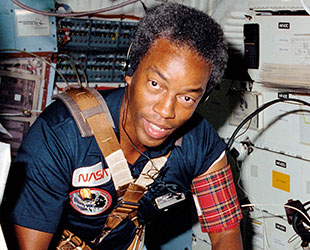 advertisements advertisements
|

|
Bluford marks 20 years since STS-8

Astronaut Guion "Guy" Bluford, the first African-American to fly in space, uses a treadmill on the space shuttle Challenger during the STS-8 mission in September 1983. (NASA) |
April 29, 2003 — When the space shuttle Challenger launched August 30, 1983, one astronaut on-board the orbiter chuckled with excitement all the way into space, and he made history along the way.
Twenty years later, Guion "Guy" Bluford's memories of his STS-8 flight are just as vivid as they were on that summer night. It was the first shuttle night launch and landing and he was the first African-American in space.
"It was around midnight and it was raining," Bluford recalls today. "We came down the elevator, heading to 'the bird,' what we called the Shuttle, and all these people were standing there cheering us on. When the clock counted down and we took off, I just laughed, it was so much fun," he said.
Though his achievement instantly thrust him into the spotlight as a role model for young African-Americans, Bluford says his goal was never to be the first African-American in space. "I recognized the importance of it, but I didn't want to be a distraction for my crew," he said. "We were all contributing to history and to our continued exploration of space."
Instead, Bluford says his goal was "to make others feel comfortable" with African-Americans in space.
"I felt I had to do the best job I could for people like the Tuskegee Airmen, who paved the way for me, but also to give other people the opportunity to follow in my footsteps," Bluford said. The Tuskegee Airmen made history as the first black flying squadron in World War II.
Bluford's interest in flying dates back to his days in junior high school, making model airplanes and wanting to learn more about jet and rocket engines. Though he wanted to become an aerospace engineer, he became an Air Force fighter pilot in 1966, eventually flying combat missions over Vietnam. When he returned from the war, Bluford began teaching others to fly, but soon decided he was ready to learn more about flying at a much higher altitude.
In 1977 he applied to NASA to become an astronaut. A year later, he was selected for the program, along with two other African-Americans, Fred Gregory and Ronald McNair. But it wasn't until 1982, in a meeting with George Abbey, then director of flight crew operations at NASA's Johnson Space Center (JSC), that Bluford realized he was headed to space.
"Dale Gardner, Dan Brandenstein, Dick Truly and I were all sitting in Abbey's office," he recalls. "Abbey said, 'I'm looking for a crew for STS-8, and I was wondering if you were interested?' It was quite a thrill."
Before the flight, NASA kept Bluford out of the news media spotlight, so he could focus on his mission. It also helped; much of the attention was still focused on Sally Ride, who had just made history on the previous Shuttle flight as the first American woman in space.
Bluford and the crew of STS-8, including fifth crewmember Bill Thornton, trained at JSC for 15 months, before heading to Kennedy Space Center, Fla., for their rainy launch early on August 30.
With the cockpit dark, Bluford recalls fellow astronaut Shannon Lucid, who would fly on five future Shuttle missions, strapping him into his seat between Brandenstein, the pilot, and Shuttle Commander Truly. The clock counted down, and the Challenger lifted off. Over the next six days, Bluford and the crew deployed INSAT-1B, a multipurpose Indian satellite, and they conducted medical measurements to understand the effects of space flight on the human body.
The one thing he didn't have to worry about was his appetite. "We had little sandwiches tied to our seats, and when we got on orbit a couple of crewmembers weren't feeling well as they adapted to space, so they passed on lunch," Bluford said. "I felt fine. I not only ate my lunch, but part of theirs, too," he said.
Following Challenger's successful early morning landing at 12:30 a.m., Sept. 5, 1983, Bluford went on a three-month national speaking tour, thanking the public for supporting him, the crew of STS-8 and the Shuttle program. He was a crewmember on three more Shuttle missions, STS-61A, STS-39 and STS-53, before retiring from the Astronaut Corps in 1993. "I was very lucky to have had four successful missions," Bluford said. "When you went out to the pad with me, everything pretty much went as planned." |

© 1999-2025 collectSPACE. All rights reserved.

|
|

|

|
